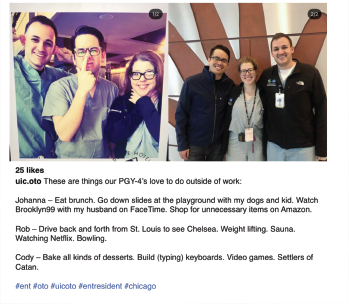
Figure 2. © Courtesy John Wilson IV
Initially, Dr. Curran wasn’t sure what he was looking for, but after viewing multiple Instagram accounts, it became clear: He noticed which programs posted more about their residents, whether it was a personal spotlight, a highlight of an accomplishment, or an announcement of future plans. He also sought posts depicting social events to form an impression of whether or not he would fit in with that residency’s culture. Traditionally, students would have the opportunity to more comprehensively learn about these aspects of residency programs via visiting student rotations, though this Match cycle’s unique challenges precluded this opportunity.
Explore This Issue
January 2022Dr. Curran noted that following these Instagram accounts was also helpful for staying informed about these programs as the 2021 application season progressed. Instagram ensured that residency candidates were aware of information sessions, opportunities to meet current residents, and other important announcements—some of which were exclusive to Instagram.
Of course, using Instagram for information about residency programs comes with limitations. Dr. Curran said that candidates must be aware of the curation intrinsic to social media platforms like Instagram—they’ll only see the good things. In addition, even if a residency program has an official account, candidates shouldn’t assume that all important residency-related information and announcements will be communicated through Instagram. This strategy should be a supplement to, not a mainstay of, the Match process.
The Academic Otolaryngologist Perspective
Even though Dr. Yu is a member of the millennial generation, he has avoided popular trends such as Twitter, Instagram, and other forms of social media. However, as he watched the evolving landscape of residency programs joining Instagram, he recognized the advantages of this technology to illustrate his role in an otolaryngology residency program available to prospective applicants.
He can add content and his perspective to support the messaging and values demonstrated by the university’s resident account. By using the tagging function, his content can be amplified to reach a larger audience. Putting in the work to create the content can be done efficiently and in real time using a smart phone; his academic practice naturally produces the content. For example, in his department, Dr. Yu serves as undergraduate medical education director, and he has been able to use Instagram as a platform to communicate his education initiatives, publications, and passion for otology and endoscopic pictures of the eardrum to students.
The greatest reward, though, has been the online comradery. A common theme on otolaryngology residency accounts is to post on the resiliency of faculty, residents, and staff as they navigate the COVID-19 pandemic. Posts follow them as they continue to provide patient care, fulfill educational missions, and promote wellness in the face of the risk of contracting the virus, the need to social distance, and moving to online teaching.
The focus on candid photos and images creates and conveys ideas, values, personalities, and interpersonal interactions that are both genuine and unique.
In one pandemic year, otolaryngology residency programs made the leap to social media as a technology that facilitates easy dissemination and publication of information. Text and pictures become profound messages to an audience of followers. Current generations of academic otolaryngologists can connect with younger members and provide information about their faculty profile that is authentic and immediate. Future generations of otolaryngologists will continue to participate in social media in a professional manner, and this technology will foster ongoing connection in our greater otolaryngology community.
Dr. Yu is an assistant professor in the department of otolaryngology at the University of Illinois in Chicago (UIC). Dr. Curran is an otolaryngology resident at the University of Cincinnati. Dr. Wilson is an otolaryngology resident at UIC.